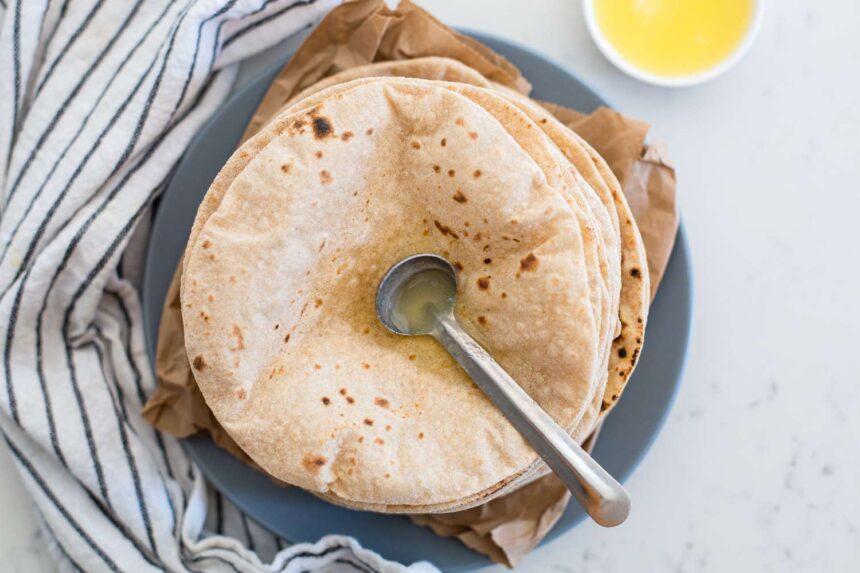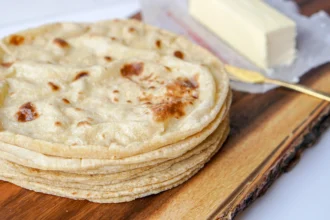Making soft, fluffy, and round rotis starts with one thing: the perfect roti dough. For many first-time cooks, making dough can feel confusing. How much water should you add? How long should you knead? Should you use oil or not? In this guide, you will learn a no-fail roti dough recipe that is simple, quick, and perfect even for beginners.
- What Makes a No-Fail Roti Dough Recipe?
- Ingredients Needed for Perfect Roti Dough
- Step-by-Step No-Fail Roti Dough Recipe for First-Time Cooks
- How to Roll the Dough into Rotis
- How to Cook the Rotis
- Tips to Make Sure Your Roti Dough Never Fails
- Common Mistakes First-Time Cooks Make with Roti Dough
- Why This Roti Dough Method Works Every Time
- More Beginner-Friendly Recipes for You
- Frequently Asked Questions (FAQs)
- Final Thoughts
This easy method works every time. You only need basic ingredients, your hands, and a little patience. Once you understand the right water-to-flour ratio and kneading time, you will be able to make soft rotis for breakfast, lunch, and dinner without any stress.
If you are learning to cook for the first time, you may also enjoy other simple recipes on our website. You can explore more beginner-friendly guides at My First Recipe.
Let’s get started with the easiest way to make roti dough from scratch.
What Makes a No-Fail Roti Dough Recipe?
A no-fail recipe is one that works every single time, even if you are cooking for the very first time. For roti dough, it means:
The dough must be soft, smooth, and elastic.
It should not be dry or sticky.
It should be easy to roll.
It should make rotis that puff nicely and stay soft for hours.
The secret lies in three things: using the right flour, adding the right amount of water, and kneading patiently. Once you understand these steps, you will never fear making dough again.
Ingredients Needed for Perfect Roti Dough
You only need a few basic ingredients to make your roti dough:
Whole wheat flour
Water
Salt (optional)
Oil (optional)
Most people prefer using only whole wheat flour and water. However, adding a teaspoon of oil helps beginners prevent the dough from drying out. Salt is also optional, but some people prefer the taste it adds.
Step-by-Step No-Fail Roti Dough Recipe for First-Time Cooks
Let’s look at the easiest way to make roti dough at home. This method is ideal for beginners and gives soft rotis every single time.
Step 1: Measure the Flour
For two people, one cup of whole wheat flour is usually enough. If you want to make more rotis, you can increase the quantity. Always use a proper measuring cup so that the recipe stays accurate.
Place the flour in a wide bowl. This gives you more space to mix and knead the dough easily.
Step 2: Add Water Slowly
This is the most important step for beginners. Never add all the water at once. Slowly pour a little water over the flour and start mixing with your fingers.
As you mix, the flour will begin to come together. Add more water only when needed. Adding too much water is the biggest mistake first-time cooks make. It makes the dough sticky and difficult to fix.
For one cup of flour, you usually need around half a cup of water, but the exact amount can vary depending on the flour brand and weather.
Step 3: Knead the Dough
Once the dough starts forming, begin kneading it using your palm. Press, fold, and turn the dough again and again.
Knead for at least 5 to 7 minutes. This is what makes the dough soft and elastic.
If the dough feels too dry, sprinkle a little water. If it feels too sticky, dust with a bit of flour.
At the end, the dough should feel soft and smooth. When you press it gently, it should bounce back slightly.
Step 4: Add Oil (Optional)
Some people like to spread a few drops of oil on the dough at the end. This helps keep the dough soft for longer. It also prevents cracks while rolling.
Adding oil is optional, but it is very helpful for beginners.
Step 5: Rest the Dough
Let the dough rest for 10 to 15 minutes. Resting makes the gluten relax, which helps in making soft rotis that roll easily and stay fluffy.
Do not skip this step. Even a short resting time makes a big difference in how your rotis turn out.
How to Roll the Dough into Rotis
Once the dough is ready, divide it into small balls. Each ball should be smooth and even. Dust it lightly with flour and start rolling using a rolling pin.
Use gentle pressure and roll evenly on all sides. Rotate the dough as you roll to keep it round.
Do not use too much flour, or the roti may become dry. A light dusting is enough.
Rolling takes practice, so do not worry if your rotis are not perfectly round at first. Over time, you will get better.
How to Cook the Rotis
Heat a tawa on medium flame. Place the rolled roti on the tawa and wait until small bubbles appear. Flip it to the other side.
After a few seconds, flip again and press lightly with a cloth or spatula. This helps the roti puff.
If you prefer, you can puff it directly on the flame. This gives the roti a soft and smoky taste.
Once cooked, store the rotis in a container lined with a cloth so they stay warm and soft.
Tips to Make Sure Your Roti Dough Never Fails
Making perfect dough takes practice, but these simple tips will help you get great results every time.
Always add water gradually.
Knead for at least 5 minutes.
Let the dough rest before rolling.
Do not use too much dry flour while rolling.
Do not overcook the rotis or they will turn hard.
Use fresh whole wheat flour for best results.
With these tips, even first-time cooks can make soft rotis without stress.
Common Mistakes First-Time Cooks Make with Roti Dough
Many beginners make the same mistakes, but the good news is that they are easy to fix.
Adding too much water makes the dough sticky.
Skipping the kneading step makes the dough hard.
Not resting the dough leads to rigid rotis.
Using old flour can affect the taste and texture.
Once you avoid these mistakes, you will find roti-making much easier.
Why This Roti Dough Method Works Every Time
This recipe uses the simplest technique and focuses on consistency. When beginners follow the correct ratio of water to flour, knead properly, and rest the dough, they get perfect results.
This method also uses basic ingredients that are always available. You do not need any special tools or expertise. It is designed for first-time cooks who want a foolproof way to make rotis that turn out soft and tasty.
More Beginner-Friendly Recipes for You
If you are learning to cook, you would love exploring simple and easy recipes on our website. Visit My First Recipe for step-by-step beginner guides that you can try at home without any experience.
You can check more recipes, kitchen tips, and quick cooking guides
Frequently Asked Questions (FAQs)
Why is my roti dough too hard?
Your dough is hard because you added less water or did not knead long enough. Add a little water and knead again to soften it.
Why is my dough sticky?
Sticky dough happens when too much water is added. Sprinkle a little flour and knead until it becomes smooth.
How long should I knead roti dough?
Knead the dough for at least 5 to 7 minutes. This makes the dough elastic and soft.
Do I need to add oil to the dough?
No, oil is optional. However, adding a teaspoon of oil can help beginners get softer dough.
How long can roti dough last?
Roti dough stays good for up to 24 hours in the refrigerator. Always store it in an airtight container.
Why don’t my rotis puff?
Rotis do not puff when the dough is too hard, not rolled evenly, or the tawa is not hot enough.
Final Thoughts
Making roti dough for the first time does not have to be difficult. With the right steps and a little practice, you can prepare soft, fluffy rotis that taste delicious. This no-fail recipe is perfect for beginners who want to build confidence in the kitchen. Follow the steps, avoid common mistakes, and soon you will master the art of making rotis at home.
For more beginner-friendly recipes, visit My First Recipe and start your cooking journey today.




